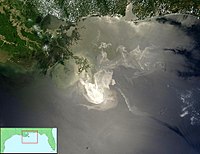
Photo from wikipedia
Oil spill model simulations of a deepwater blowout in the Gulf of Mexico De Soto Canyon, assuming no intervention and various response options (i.e., subsea dispersant injection SSDI, in addition… Click to show full abstract
Oil spill model simulations of a deepwater blowout in the Gulf of Mexico De Soto Canyon, assuming no intervention and various response options (i.e., subsea dispersant injection SSDI, in addition to mechanical recovery, in-situ burning, and surface dispersant application) were compared. Predicted oil fate, amount and area of surfaced oil, and exposure concentrations in the water column above potential effects thresholds were used as inputs to a Comparative Risk Assessment to identify response strategies that minimize long-term impacts. SSDI reduced human and wildlife exposure to volatile organic compounds; dispersed oil into a large water volume at depth; enhanced biodegradation; and reduced surface water, nearshore and shoreline exposure to floating oil and entrained/dissolved oil in the upper water column. Tradeoffs included increased oil exposures at depth. However, since organisms are less abundant below 200 m, results indicate that overall exposure of valued ecosystem components was minimized by use of SSDI.
Journal Title: Marine pollution bulletin
Year Published: 2018
Link to full text (if available)
Share on Social Media: Sign Up to like & get
recommendations!